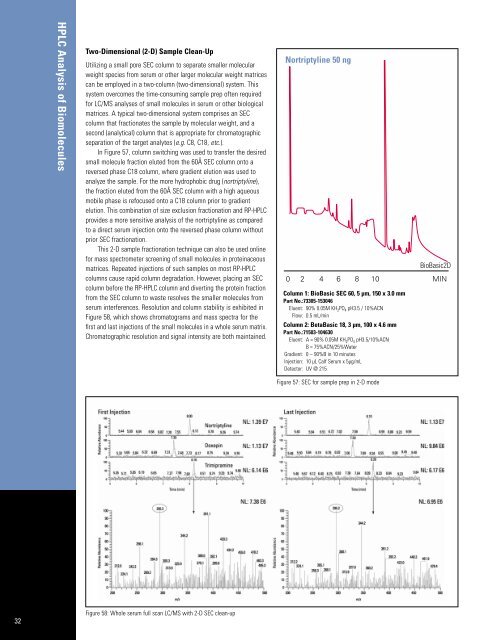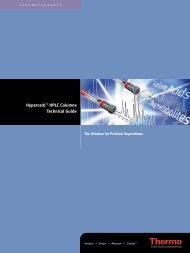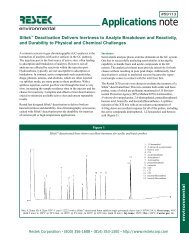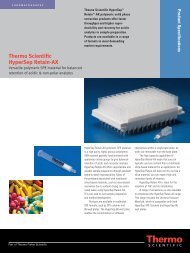HPLC Analysis of Biomolecules Technical Guide - Interscience
HPLC Analysis of Biomolecules Technical Guide - Interscience
HPLC Analysis of Biomolecules Technical Guide - Interscience
Create successful ePaper yourself
Turn your PDF publications into a flip-book with our unique Google optimized e-Paper software.
32<br />
<strong>HPLC</strong> <strong>Analysis</strong> <strong>of</strong> <strong>Biomolecules</strong><br />
Two-Dimensional (2-D) Sample Clean-Up<br />
Utilizing a small pore SEC column to separate smaller molecular<br />
weight species from serum or other larger molecular weight matrices<br />
can be employed in a two-column (two-dimensional) system. This<br />
system overcomes the time-consuming sample prep <strong>of</strong>ten required<br />
for LC/MS analyses <strong>of</strong> small molecules in serum or other biological<br />
matrices. A typical two-dimensional system comprises an SEC<br />
column that fractionates the sample by molecular weight, and a<br />
second (analytical) column that is appropriate for chromatographic<br />
separation <strong>of</strong> the target analytes (e.g. C8, C18, etc.).<br />
In Figure 57, column switching was used to transfer the desired<br />
small molecule fraction eluted from the 60Å SEC column onto a<br />
reversed phase C18 column, where gradient elution was used to<br />
analyze the sample. For the more hydrophobic drug (nortriptyline),<br />
the fraction eluted from the 60Å SEC column with a high aqueous<br />
mobile phase is refocused onto a C18 column prior to gradient<br />
elution. This combination <strong>of</strong> size exclusion fractionation and RP-<strong>HPLC</strong><br />
provides a more sensitive analysis <strong>of</strong> the nortriptyline as compared<br />
to a direct serum injection onto the reversed phase column without<br />
prior SEC fractionation.<br />
This 2-D sample fractionation technique can also be used online<br />
for mass spectrometer screening <strong>of</strong> small molecules in proteinaceous<br />
matrices. Repeated injections <strong>of</strong> such samples on most RP-<strong>HPLC</strong><br />
columns cause rapid column degradation. However, placing an SEC<br />
column before the RP-<strong>HPLC</strong> column and diverting the protein fraction<br />
from the SEC column to waste resolves the smaller molecules from<br />
serum interferences. Resolution and column stability is exhibited in<br />
Figure 58, which shows chromatograms and mass spectra for the<br />
first and last injections <strong>of</strong> the small molecules in a whole serum matrix.<br />
Chromatographic resolution and signal intensity are both maintained.<br />
Figure 58: Whole serum full scan LC/MS with 2-D SEC clean-up<br />
Nortriptyline 50 ng<br />
0 2 4 6 8 10 MIN<br />
Column 1: BioBasic SEC 60, 5 µm, 150 x 3.0 mm<br />
Part No.:73305-153046<br />
Eluent: 90% 0.05M KH 2 PO 4 pH3.5 / 10%ACN<br />
Flow: 0.5 mL/min<br />
Column 2: BetaBasic 18, 3 µm, 100 x 4.6 mm<br />
Part No.:71503-104630<br />
Eluent: A = 90% 0.05M KH 2PO 4 pH3.5/10%ACN<br />
B = 75%ACN/25%Water<br />
Gradient: 0 – 90%B in 10 minutes<br />
Injection: 10 µL Calf Serum x 5µg/mL<br />
Detector: UV @ 215<br />
Figure 57: SEC for sample prep in 2-D mode<br />
BioBasic2D





